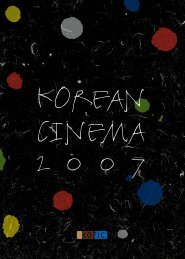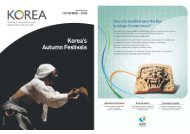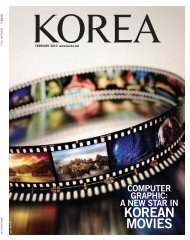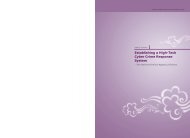2005-2162 The Buddha’s birthday illuminates Seoul
The Buddha's birthday illuminates Seoul - Korea.net
The Buddha's birthday illuminates Seoul - Korea.net
- No tags were found...
You also want an ePaper? Increase the reach of your titles
YUMPU automatically turns print PDFs into web optimized ePapers that Google loves.
Global Korea<br />
Jang Si-jung, vice<br />
president of Koica, and<br />
Guatemalan Vice President<br />
Rafael Espada shake<br />
hands (right) at the<br />
center’s official opening<br />
on March 18.<br />
Provided by KOICA<br />
Charity’s hiking dentists<br />
save Himalayan mouths<br />
<strong>The</strong> Purme<br />
Foundation<br />
in Nepal<br />
Joint technical training center<br />
opens in Guatemalan capital<br />
Anew training center in Guatemala<br />
is emblematic of Korean<br />
KOICA<br />
efforts to share technical<br />
in Guatemala<br />
knowledge around the world.<br />
After three years under construction,<br />
the largest information and communications<br />
technology, or ICT, training center<br />
in Central America opened on March 18<br />
in Guatemala City, Guatemala.<br />
<strong>The</strong> Korea-Guatemala ICT Training<br />
Center, built with the technical assistance of<br />
the Korea International Cooperation Agency, is a<br />
seven-story building where computer classes are conducted<br />
for Guatemalan government officials, corporate<br />
workers and ordinary citizens.<br />
Though Guatemala is steadily developing its information<br />
and communications technology, many people<br />
in Central American nations are still unfamiliar with<br />
how to use the Internet and other computer program<br />
tools, according to a Koica official.<br />
So, at the request of the Guatemalan government,<br />
Koica launched the training center project with a grant<br />
of $2.5 million in February 2006.<br />
<strong>The</strong> Guatemalan government, which intended to<br />
spend another $2.5 million from its own budget on the<br />
center, increased the amount to $3.5 million, since<br />
fostering human resource development and information<br />
and communications technology are two of its<br />
four major development goals.<br />
“Originally planned to have four stories, the center<br />
turned into a seven-story building with the additional<br />
funding. This reflects how the Guatemalan government<br />
wanted to improve its ICT infrastructure,” said<br />
Kim Jung-hoon, media relations officer at Koica.<br />
Koica not only supervised construction of the center,<br />
but also dispatched IT specialists to install computers<br />
and software. In summer 2007, training sessions<br />
were offered in Korea for Guatemalan administrators<br />
and instructors to help them efficiently manage and<br />
operate the training center.<br />
At an opening ceremony attended by over 500 dignitaries,<br />
Guatemala’s Vice President Rafael Espada<br />
said, “Science and technology are valuable tools, and<br />
are essential in promoting orderly development and<br />
growth for the country and the region.”<br />
“I am very grateful to Korea for its friendship with<br />
our country and for sharing with Guatemala the<br />
advances in technology that have improved the quality<br />
of life of Koreans,” Espada said.<br />
Kim said the center, located at the Calle del Estadio<br />
Mateo Flores in the Guatemalan capital, currently<br />
offers classes to nearly 700 trainees on topics that<br />
include using the Internet, databases, application<br />
development, operating systems, networks and 3-D<br />
animation. “Koica hopes that the establishment of the<br />
ICT center will allow the Guatemalan government to<br />
achieve its goal, taking the lead in the standards of IT<br />
training centers in Central America,” Kim commented.<br />
“When word of the state-of-the-art facility spreads<br />
across Central America, Koica will be getting more<br />
requests from other countries for technical aid,” he<br />
predicted. “This will naturally help spread Korean IT<br />
know-how to other countries, which as a result will<br />
raise Korea’s international status and strengthen its<br />
international cooperation.” By Kim Mi-ju<br />
Provided by the Purme Foundation<br />
It was a climb difficult to enjoy. Trudging up a trail<br />
at 3,450 meters above sea level left a few in the<br />
group ill from the altitude. But these dentists had<br />
a mission to accomplish, and one of them, Jung<br />
Tae-young, even called it a “gratifying experience” and<br />
is certain he will be back on this trail again.<br />
<strong>The</strong> group of 27 dentists, nurses and volunteers<br />
were in northeast Nepal in late January as part of a<br />
medical outreach program established by the Korean<br />
Purme Foundation, which works to help the disabled.<br />
<strong>The</strong> two-day hike was part of an eight-day itinerary.<br />
<strong>The</strong>ir goal: Namche Bazaar, the gateway to Mount<br />
Everest, where the <strong>Seoul</strong>-based foundation launched a<br />
temporary free dental clinic, its first abroad.<br />
“We plan to revisit the same village periodically so<br />
that we can see the progress in the condition of the<br />
locals’ teeth,” said Jung, who is a team head at Purme.<br />
“That way we are really contributing continuous aid.”<br />
<strong>The</strong> only dental clinic in Namche Bazaar closes in<br />
the winter. When Purme’s outreach team started its<br />
free temporary service, local residents said they walked<br />
for days to line up and receive help. On Jan. 25, Purme<br />
volunteers extracted 162 teeth and taught 273 how to<br />
brush their teeth, according to their records.<br />
Dr. Seok Do-jun, left, and<br />
college student volunteer<br />
Chun Han treat a young<br />
dental patient.<br />
Dr. Lee Geum-suk, a dental professor, was one of<br />
the volunteers. She saw that the local residents who<br />
had received higher education, and those who worked<br />
as trekking guides, had better teeth than the less educated.<br />
She said she was concerned to find a woman<br />
who appeared from her teeth to be in her 60s was actually<br />
only in her late 30s. <strong>The</strong> widespread habit of chewing<br />
tobacco was another factor contributing to the<br />
situation, she noted.<br />
<strong>The</strong> trip was spearheaded by a dental service arm<br />
run by Purme. <strong>The</strong> foundation explained that it plans<br />
to expand the service into other medical fields as well,<br />
replicating its rehabilitation centers for the disabled in<br />
<strong>Seoul</strong> abroad.<br />
<strong>The</strong> Purme Foundation is the brainchild of Whang<br />
Hye Kyung, who had one leg amputated after a traffic<br />
accident 10 years ago in Britain, and created it after<br />
discovering that Korea lacked the facilities to look after<br />
the disabled properly. When her British insurance<br />
company paid her claim, she used 100 million won<br />
($75,216) of it to establish the Purme Foundation in<br />
<strong>2005</strong> to help others like her. Her foundation is now<br />
raising funds to build a rehabilitation hospital with 50<br />
beds within this year. By Lee Min-ah<br />
16 korea May 2009 May 2009 korea 17

















